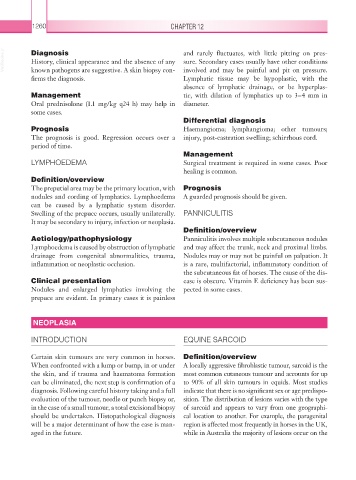Page 1285 - Equine Clinical Medicine, Surgery and Reproduction, 2nd Edition
P. 1285
1260 CHAPTER 12
VetBooks.ir Diagnosis and rarely fluctuates, with little pitting on pres-
sure. Secondary cases usually have other conditions
History, clinical appearance and the absence of any
known pathogens are suggestive. A skin biopsy con-
Lymphatic tissue may be hypoplastic, with the
firms the diagnosis. involved and may be painful and pit on pressure.
absence of lymphatic drainage, or be hyperplas-
Management tic, with dilation of lymphatics up to 3–4 mm in
Oral prednisolone (1.1 mg/kg q24 h) may help in diameter.
some cases.
Differential diagnosis
Prognosis Haemangioma; lymphangioma; other tumours;
The prognosis is good. Regression occurs over a injury, post-castration swelling; schirrhous cord.
period of time.
Management
LYMPHOEDEMA Surgical treatment is required in some cases. Poor
healing is common.
Definition/overview
The preputial area may be the primary location, with Prognosis
nodules and cording of lymphatics. Lymphoedema A guarded prognosis should be given.
can be caused by a lymphatic system disorder.
Swelling of the prepuce occurs, usually unilaterally. PANNICULITIS
It may be secondary to injury, infection or neoplasia.
Definition/overview
Aetiology/pathophysiology Panniculitis involves multiple subcutaneous nodules
Lymphoedema is caused by obstruction of lymphatic and may affect the trunk, neck and proximal limbs.
drainage from congenital abnormalities, trauma, Nodules may or may not be painful on palpation. It
inflammation or neoplastic occlusion. is a rare, multifactorial, inflammatory condition of
the subcutaneous fat of horses. The cause of the dis-
Clinical presentation ease is obscure. Vitamin E deficiency has been sus-
Nodules and enlarged lymphatics involving the pected in some cases.
prepuce are evident. In primary cases it is painless
NEOPLASIA
INTRODUCTION EQUINE SARCOID
Certain skin tumours are very common in horses. Definition/overview
When confronted with a lump or bump, in or under A locally aggressive fibroblastic tumour, sarcoid is the
the skin, and if trauma and haematoma formation most common cutaneous tumour and accounts for up
can be eliminated, the next step is confirmation of a to 90% of all skin tumours in equids. Most studies
diagnosis. Following careful history taking and a full indicate that there is no significant sex or age predispo-
evaluation of the tumour, needle or punch biopsy or, sition. The distribution of lesions varies with the type
in the case of a small tumour, a total excisional biopsy of sarcoid and appears to vary from one geographi-
should be undertaken. Histopathological diagnosis cal location to another. For example, the paragenital
will be a major determinant of how the case is man- region is affected most frequently in horses in the UK,
aged in the future. while in Australia the majority of lesions occur on the

